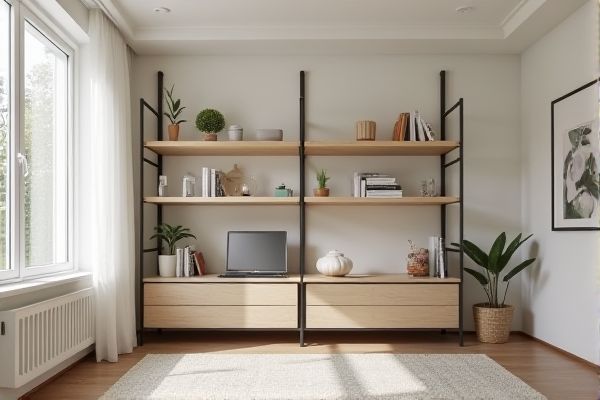
Riser shelves elevate items to create additional vertical storage space, making them ideal for organizing desks or countertops, while stackable shelves provide modular flexibility by allowing multiple units to be stacked and customized based on your storage needs. Explore the rest of the article to discover which shelving solution best suits your space and organizational goals.
Table of Comparison
| Feature | Riser Shelf | Stackable Shelf |
|---|---|---|
| Design | Single elevated shelf to increase vertical space | Multiple shelves designed to be stacked vertically |
| Installation | Placed on existing surfaces without assembly | Requires stacking and securing multiple units |
| Use Case | Ideal for organizing desk, kitchen, or closet spaces | Best for modular storage in closets, pantries, or offices |
| Adjustability | Fixed height and size | Typically adjustable by adding or removing shelves |
| Material | Often plastic, wood, or metal | Varies; plastic, metal, or wood with locking mechanisms |
| Weight Capacity | Supports moderate weight per shelf | Handles heavier loads due to distributed stacking |
| Portability | Lightweight and easy to relocate | Heavier; less portable when fully assembled |
| Price Range | Generally budget-friendly | Varies from affordable to premium, depending on design |
Introduction to Riser Shelves and Stackable Shelves
Riser shelves elevate items to create additional vertical storage space, which maximizes organization on countertops, desks, or closets. Stackable shelves are modular units designed to be placed directly on top of each other, allowing customizable height configurations for optimized space utilization. Both storage solutions improve accessibility and visibility by efficiently layering items in compact areas.
Key Differences Between Riser and Stackable Shelves
Riser shelves elevate items by providing a single tier platform that improves visibility and access, while stackable shelves consist of multiple interlocking units designed for vertical expansion and space maximization. Riser shelves are typically fixed in height, ideal for displaying items at different levels, whereas stackable shelves offer customizable height adjustments and modular configurations for versatile storage. The choice depends on the need for fixed elevation versus adaptable stacking to optimize organization and display efficiency.
Space Efficiency: Riser Shelf vs Stackable Shelf
Riser shelves maximize vertical space by elevating items in tiers, allowing clear visibility and easy access without increasing the footprint. Stackable shelves offer flexible height adjustments and customizable configurations but may occupy more horizontal space when stacked higher. Your choice depends on whether you prioritize compact vertical organization or adaptable stacking options for diverse storage needs.
Installation and Assembly Comparison
Riser shelves typically feature a simple, one-piece design that requires minimal installation, often just placing the unit on a flat surface, making them ideal for quick setup. Stackable shelves usually consist of multiple modular components that must be assembled using screws or connectors, allowing for customizable height but requiring more time and tools for installation. The choice between riser and stackable shelves depends on the balance between ease of assembly and desired configuration flexibility.
Durability and Material Choices
Riser shelves typically offer enhanced durability due to their solid metal or high-quality wood construction, making them suitable for heavy items and long-term use. Stackable shelves often utilize lightweight plastic or thinner metal, prioritizing flexibility and ease of rearrangement over maximum strength. Your choice depends on whether you prefer the robust stability of riser shelves or the adaptable material options of stackable designs.
Versatility in Storage Solutions
Riser shelves provide an elevated platform that maximizes vertical space, making them ideal for organizing items without increasing your storage footprint. Stackable shelves offer modular flexibility, allowing you to customize the height and configuration to fit varying storage needs and spaces. Both options enhance versatility by enabling efficient organization and accessibility in kitchens, offices, or closets.
Cost Analysis: Which Is More Economical?
Riser shelves generally cost less upfront due to their simpler design and materials, making them a budget-friendly option for basic organization needs. Stackable shelves, while typically pricier initially, offer greater long-term value by maximizing vertical space and supporting heavier loads, potentially reducing the need for additional furniture purchases. Evaluating lifetime usage and space efficiency often reveals stackable shelves as the more economical choice for extensive storage solutions.
Design and Aesthetic Appeal
Riser shelves typically feature a minimalist design with clean lines that elevate items for better visibility, making them ideal for creating an organized and modern look in your space. Stackable shelves offer versatile modularity, allowing you to customize the arrangement to suit various room aesthetics, from sleek contemporary to eclectic styles. Each option enhances your interior design by optimizing space while maintaining a balanced visual appeal.
Ideal Use Cases for Riser and Stackable Shelves
Riser shelves are perfect for organizing items that require elevation and visibility, such as kitchen spices, bathroom toiletries, or office supplies, making it easier to access frequently used objects. Stackable shelves excel in maximizing vertical storage space in closets, pantries, or garages, allowing you to customize shelf height according to your needs and efficiently store bulkier items. Your choice depends on whether you prioritize accessibility and display (riser shelf) or customizable, space-saving storage (stackable shelf).
Choosing the Right Shelf for Your Needs
Choosing the right shelf depends on your specific storage goals: riser shelves excel at providing elevated storage space for better visibility and accessibility, ideal for organizing items like kitchenware or office supplies. Stackable shelves offer modular flexibility and can be expanded vertically, perfect for maximizing limited space in closets or garages. Evaluate the available area, item sizes, and frequency of access to determine whether the fixed elevation of a riser shelf or the customizable height of stackable shelves best suits your needs.
 homyna.com
homyna.com